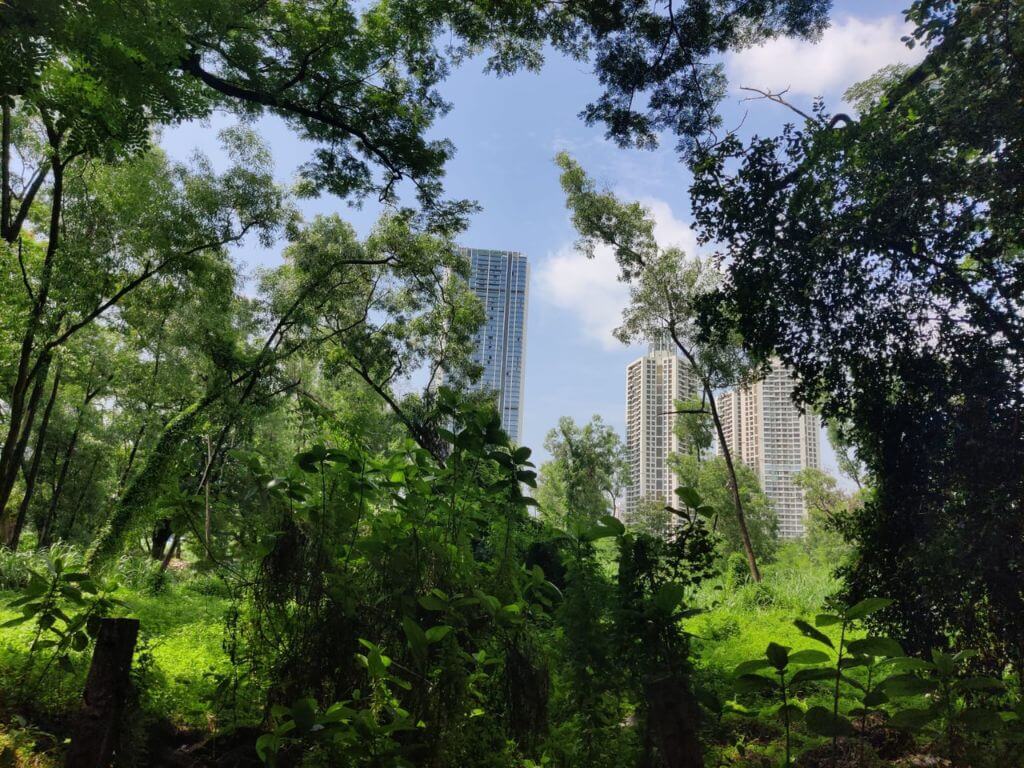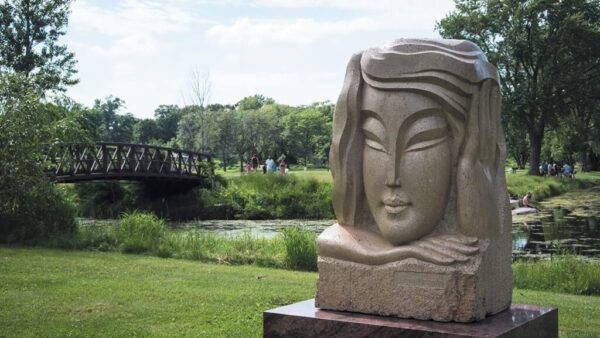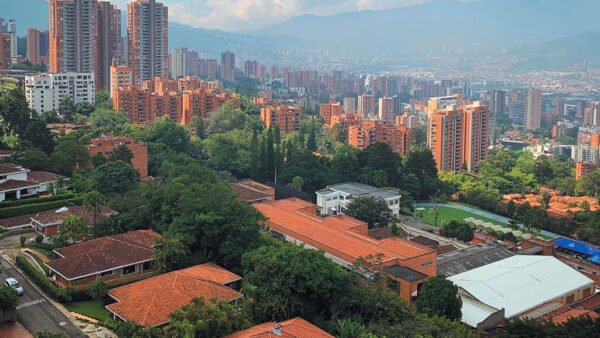The sprawling lush green forest of Mumbai’s Sanjay Gandhi National Park was in the hallowed space of the city’s iconic Chhatrapati Shivaji Maharaj Vastu Sangrahalaya or the museum’s Jehangir Nicholson Gallery. On the face of it, an odd collaboration it would seem. After all, what about a forest is worthy of an exhibition, what did the display signify? Yet, shorn of the predictable, the exhibition brought the city’s most precious natural area, tribal habitat, and biodiversity locale to the attention of many – showcasing a slice of city life that continues to be cradled in natural areas.
Titled ‘A Forest in the City: Living within Sanjay Gandhi National Park/Aarey Colony in Mumbai’, the exhibition displays the tarpa or an indigenous music instrument, a delivery return receipt because the delivery executive was unable to enter the forest or locate the “address”, and maps of lands owned by the indigenous community of Warlis which narrate the interconnected stories of their lives, rights and struggles. The real-life objects – not typical exhibition material – are a treasure that allows Mumbaikars a glimpse into the lives of people who live in the forest in ways that contrast starkly from the bustling city outside it. Seeing the objects and reading descriptions underscores an important point: the severed but undisputed connection of Mumbai with the forest, how its green cover silently protects the city, who lives inside it and what their relationship is with the city outside.
The green expanse sprawled across 103.8 square kilometres is a natural treasure, the city’s natural wealth, and its bulwark against the impact of climate change. The forest and the Adivasis in it existed long before it was deemed a protected area and given the name.[1] Contiguous with the Sanjay Gandhi National Park but more accessible to people and vulnerable to the march of urbanisation was the Aarey Forest/Colony, which over the years, has seen land parcels being hived off for ‘infrastructure’ and ‘development’.
The Adivasis who have lived for centuries within the forested area remained steadfast guardians of the forest while also, post facto, becoming citizens of Mumbai as it grew around the greens. “While the world was locked indoors during the COVID-19 pandemic, we slept under the open sky. We didn’t leave our padas to buy anything, we hardly ever do because everything we need is here,” says Prakash Bhoir, an Adivasi activist who lives in Aarey Forest. Residents of 12 padas (settlements) in the SGNP, however, face eviction.
The creeping urbanisation that threatens to intrude into the forested area, the changing identity of the Adivasis, and the reconnection needed between the city and its forest is what the exhibition sought to foreground. Conceived and assembled by the Kamla Raheja Vidyanidhi Institute for Architecture and Environmental Studies (KRVIA) and Paani Haq Samiti, and supported by UK Research and Innovation, the exhibition is the outcome of three years of research and documentation.
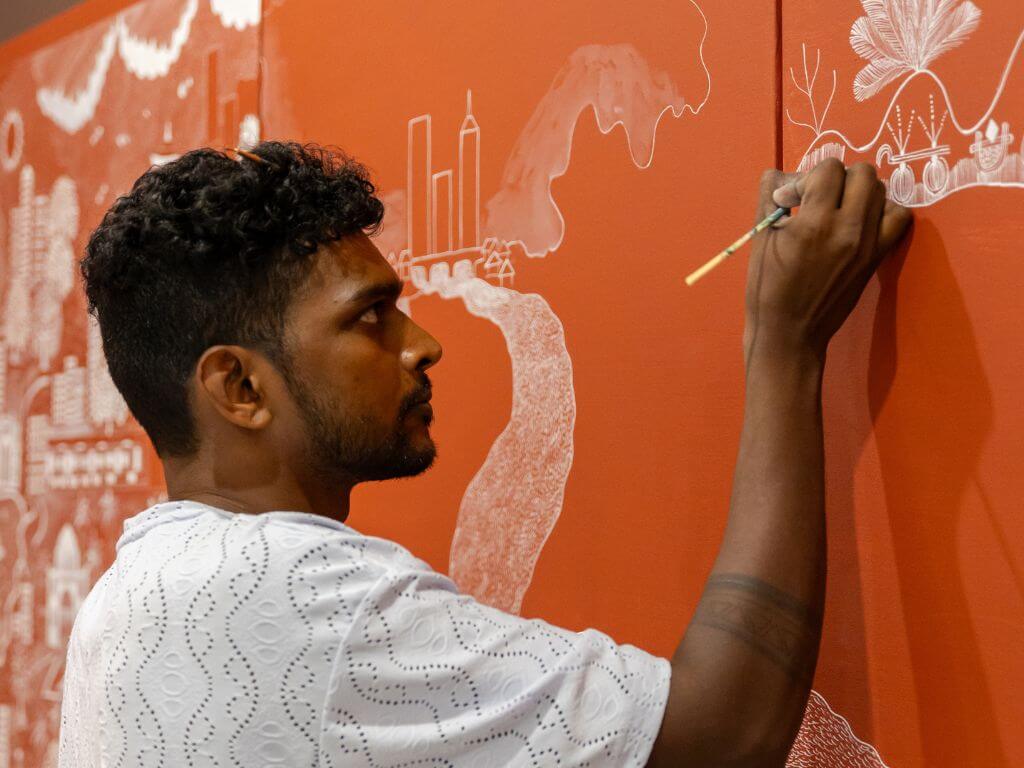
Photo: Jehangir Nicholson Art Foundation, Mumbai
“Everyone views the forest differently. We realised that access to infrastructure in the community, very often in the forest, is usually denied or allowed based on the way that the forest itself is defined,” says architect-urban designer and dean of KRVIA, Rohan Shivkumar. When the forest is threatened by planned and unplanned development, not only do the Adivasis lose their land and livelihoods but the city cuts the cord with its natural areas too. When the state recognises the land but not the people on it, it shows an ugly face of urbanisation.
Traditions and modernity
The Adivasis celebrate the festivals of Holi and Diwali but worship nature during the festivities, celebrate their harvest, and seek blessings from nature to consume fresh produce. Bhoir says, “If I put one grain into the land, it gives me at least a thousand more. How can I not consider this holy?” Adivasi gods are named after elements in nature. Hirvadev literally means ‘green god’ alluding to the greenery while Waghdev means a leopard or a tiger worshipping which, they believe, will keep them safe.
“We have never felt that animals like leopards are dangerous,” says Bhoir, tracing the contradiction with how Mumbai sees leopards, “In fact, our way of life recognises that animals have the right to this land. We worry if we don’t spot the animals that are regular here. People (of the city) feel unsafe around leopards because they have conveniently constructed on the land that belongs to these animals.”
The city coming closer to the forest – a few high rises in the vicinity advertise proximity to the National Park as a selling point – has meant that the gaodevi temple finds itself filled with images of gods more associated with Sanatani Hindus. Their brief interactions with the city, when the younger ones go for education or jobs, have gradually changed tribal traditions. They worship ‘new’ popular Hindu gods, they no longer bury their dead, and they know the importance of a caste certificate.
These strands have been given tangible form in the exhibition. On display is a death certificate by the Brihanmumbai Municipal Corporation which is a new norm here; the certificate is necessary for cremating the dead and it helps families get a proof of caste which is necessary to avail government benefits and reservation. The death certificate, an unusual exhibit, shows its new centrality to the lives of the Adivasis – and their fascination with the piece of paper they have learned to treasure.
“We have it on smartphones,” discloses Manisha Dhinde, a Warli activist, “people are giving up agriculture to seek opportunities that seem lucrative and better-paying outside the forest, but education and jobs are difficult without a caste certificate.” The exhibition highlights such shifting boundaries and realities of ancient people in a fast-paced city.
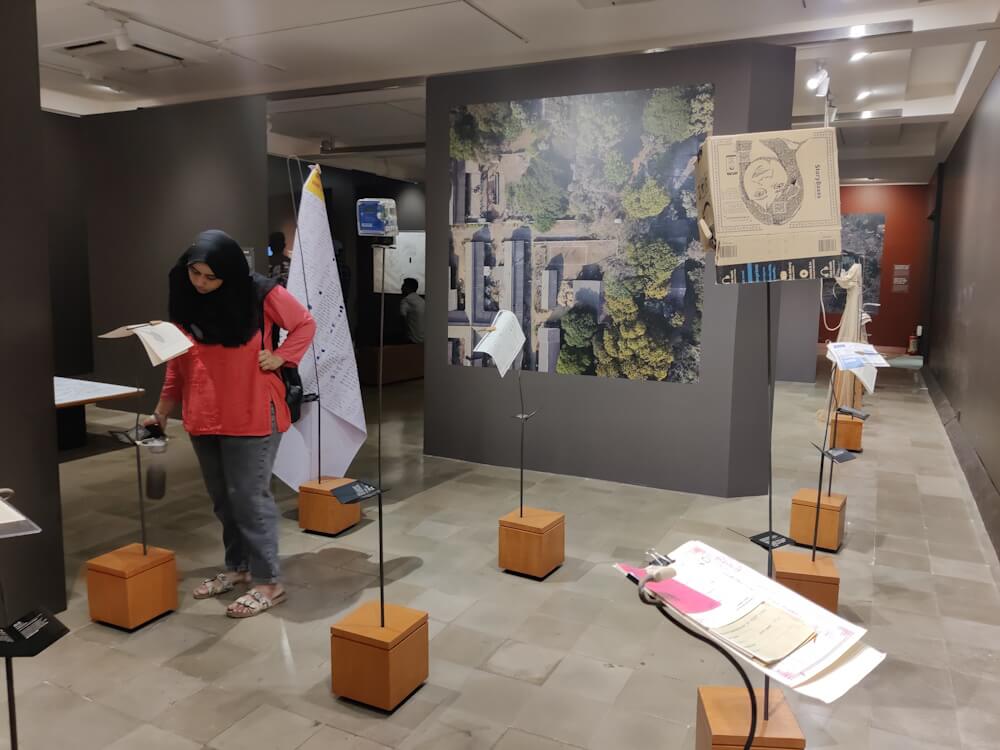
Photo: Jashvitha Dhagey
Significance of maps
The section of four maps are “institutional imaginations of the forest boundary” depicting life at the edge of the forest through Warli art. Shivkumar explains, “It was important for us to place these ideas of boundaries and the forest in conversation with each other to see the ways in which they affect each other.” The exhibition team went back to the Maharashtra State Archives to find out how the forest came to be within the city.
Simpreet Singh, well-known researcher and archivist, found that when Mumbai expanded its footprint closer to the forest, it was the Krishnagiri National Park in 1950 on the lines of the US national parks. The name changed to Borivali National Park, after the name of the suburb where it was located, before it was renamed as Sanjay Gandhi National Park. A section of the Aarey Colony nearby was turned into a milk production and supply hub for Mumbai. Singh found that the Adivasis here were denied land titles. “The Tribal Research and Training Institute has acknowledged the presence of Adivasis and padas. However, land issues have not been settled yet,” he says.
The official tag of ‘forest’ was bestowed on a large part of the 1,300 hectares of Aarey only in 2020 after the controversy over situating a metro car shed and when more than 2,200 trees were chopped off in a day-night operation. The Adivasis here have been told that they cannot be allotted land inside the SGNP. “But we were here before the forest was declared a National Park,” says Dhinde.
Without land titles, they are not eligible for an electricity connection and must rely on beg-borrow. The exhibition displays an electricity meter, again an atypical exhibit, noting it is shared by five households and the one who owns it does not pay for power as he “generously” allows his connection to be used. “Mapping natural areas becomes important to have knowledge in the public domain. People become more conscious. Otherwise, apathy sets in and someone can take advantage of the ignorance,” says Singh.
Changing green boundaries
Not only has Mumbai’s green cover steadily vanished to make way for construction, losing 2,028 hectares between 2016 and 2021[2], but the boundaries within the city’s largest green area have been changing too, diminishing it.
In 2017, the Adivasis of Prajapur pada in Aarey were shifted to make space for the metro car shed; now, residents of Nimbarpada nearer the Thane part of the forest face the same plight to make way for Goregaon-Mulund Link Road. The changing contours, as shown in the maps, reveal how long-time residents of the old forest live in constant fear of being displaced by the intruding urban expansion. The authorities have denied them documents to show their legitimate generational existence in the forest.
“We have been the guardians of this land but the authorities take it away in parcels for new infrastructure projects,” laments Dhinde. Her family, in Maroshipada of Aarey, has hung on to every piece of paper issued by the city to assert their claim over the forest. A copy of their Forest Claim Document is on display at the exhibition and contains a nazari naksha (a visual map that cannot be scaled) along with modern documents such as ration card, PAN card, voter identity card, caste certificate, and senior citizens’ card. Without the first two as proof of their traditional dependence on the forest, evidenced as cultivation tax paid, they become nowhere people. Despite all the documentation, they struggle to establish their rights over the natural area.
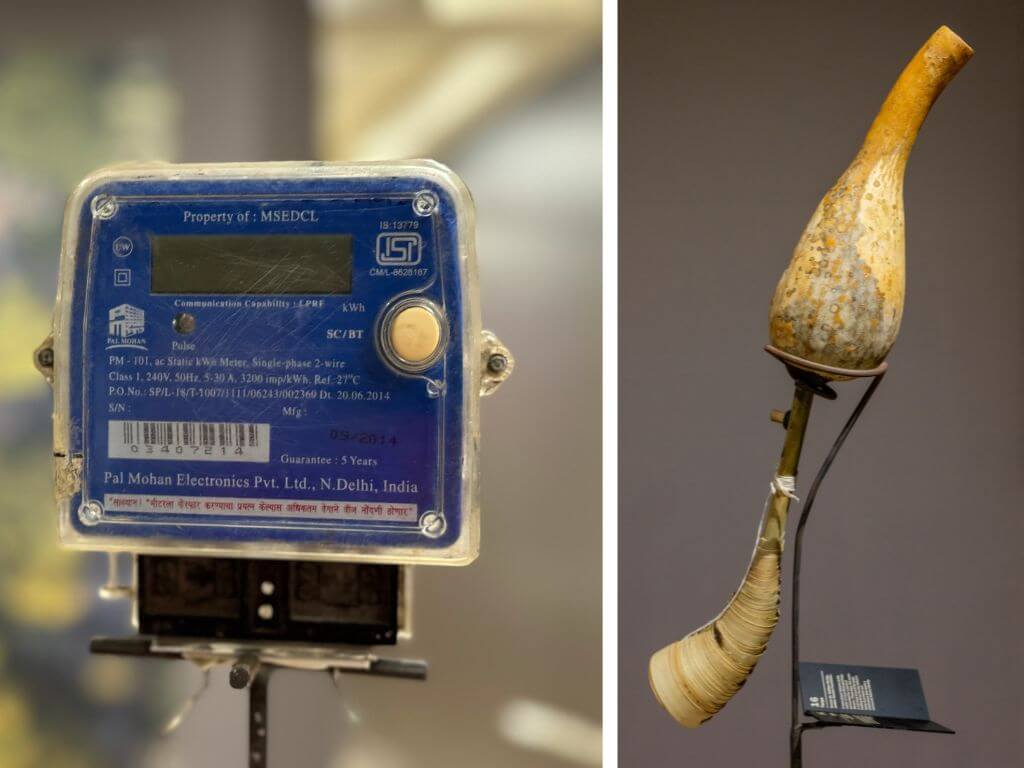
Photos: Jehangir Nicholson Art Foundation, Mumbai
Whose development?
During the research for the exhibition, Dhinde visited 88 Adivasi padas in and around Mumbai-Thane. She found that Thane’s Kashelipada had a natural water source from where a pipeline was constructed to supply water to posh apartments and bungalows in Yeoor Hills on the eastern edge of the SGNP but the Adivasis, denied water, were forced to steal it from the pipeline.
Near the SGNP, Bhoir recounts that at least three padas have been wiped out for concrete construction. Those who shifted to flats “feel like chickens in a coop” because homes cannot be extended outdoors as in the forest, he says. Residents of other padas share the plight, with no access to electricity or water connections, and other restrictions.[3]
All this appears in the exhibition as a piece of corrugated tin sheet which is readily available as opposed to traditional materials like karvi and mud which the Adivasis once used for their homes. The older Adivasis grew up seeing some construction within Aarey, like the high-end Royal Palms complex, but they fear that the rapidly vanishing green cover will mean no forest left to show their children.
After Tulsi and Vihar lakes’ water began to be supplied to Mumbai, the Adivasis were kept out of them despite the water bodies being the source of their livelihood. A traditional fishing net on display at the exhibition tells the story of Sunil, who used to sneak out to the Tulsi Lake – where generations fished – to catch fish. “The areas around the Tulsi and Vihar lakes were cordoned off after they started supplying water to the mainland,” explains Simpreet Singh.
While urban Mumbai struggles to understand and re-establish its connection with nature, the Adivasis enjoy an organic connection to all forms of natural life around them. This, ironically, is being broken. “Our Warli paintings depict nature because we see and experience it, it gives us life,” says Bhoir. When will Mumbai’s authorities acknowledge the forest’s original inhabitants?
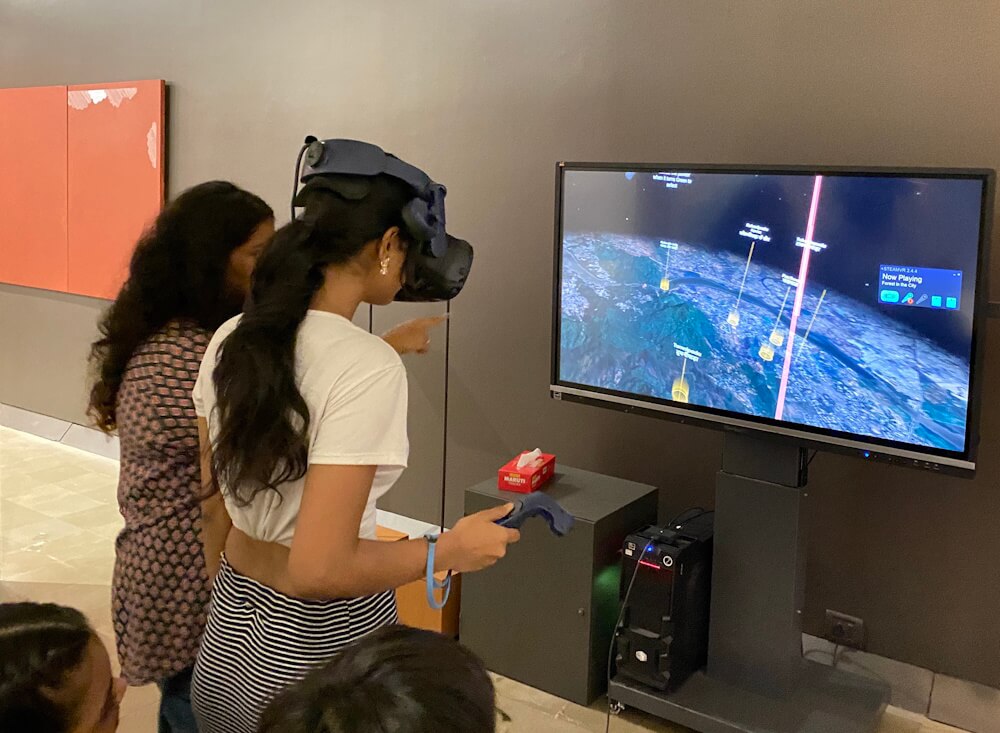
Photo: Jehangir Nicholson Art Foundation, Mumbai
The ecological question
Urbanisation continues to eat into the forest as infrastructure projects threaten the ecology. “We imagine the city’s development within a certain framework of how it is understood globally. This is thrust upon our context, and then we are surprised that there are contradictions between this imagination of development and local communities,” says Shivkumar. Adds Singh, “The imagination of the National Park is antithetical to the imagination of the city itself.”
Shivkumar suggests rethinking development for a just, free and equal city given that the city’s relationship with nature severed as it expanded. Without the forest, Mumbai’s heat waves, increased intensity of rain, and the compounding urban heat island effect might be worse. The Mumbai Climate Action Plan found that between 2016 and 2021, 308.80 tonnes of CO2 per year was removed because of the net gain of forest and more than three times that, 1067.99 tonnes of CO2 per year was emitted due to loss of forest.[4]
People in the city frame nature through our own desires while “it is often seen that the everyday lives of indigenous communities are intertwined with it,” explains Shivkumar. Without nature-led plans – and an edict that the forest green will not be touched for any ‘development’ – Mumbai’s relationship with its forests will be lost like it has with its rivers. “Why can’t we imagine every inch of the city as inclusive to humans and life beyond humans,” asks Singh.
Jashvitha Dhagey is a multimedia journalist and researcher. A recipient of the Laadli Media Award 2023, she observes and chronicles the multiple interactions between people, between people and power, and society and media. She developed a deep interest in the way cities function, watching Mumbai at work. She holds a post-graduate diploma in Social Communications Media from Sophia Polytechnic.
Cover photo: Aarey Colony in Mumbai. Credit: Jashvitha Dhagey

